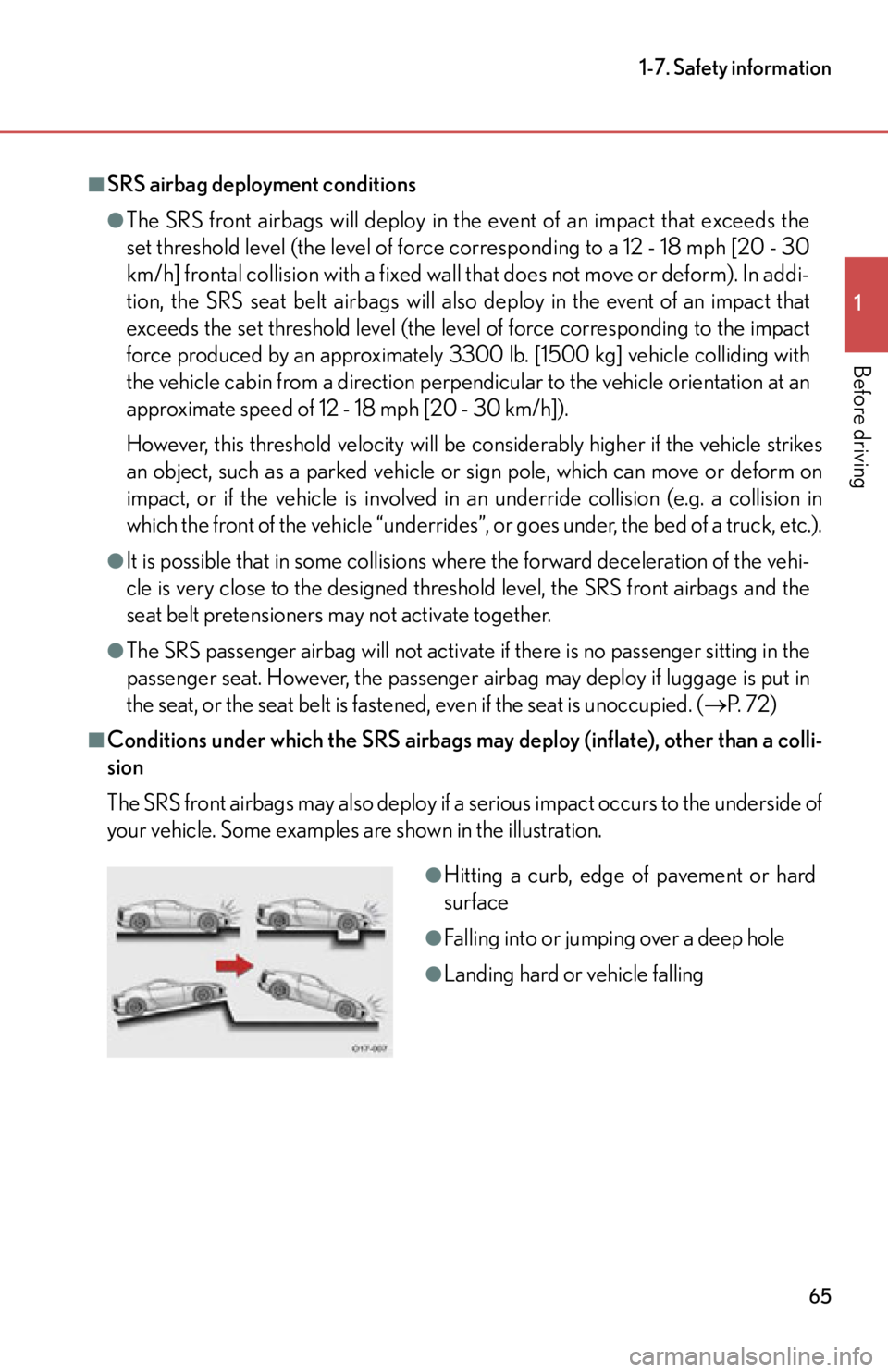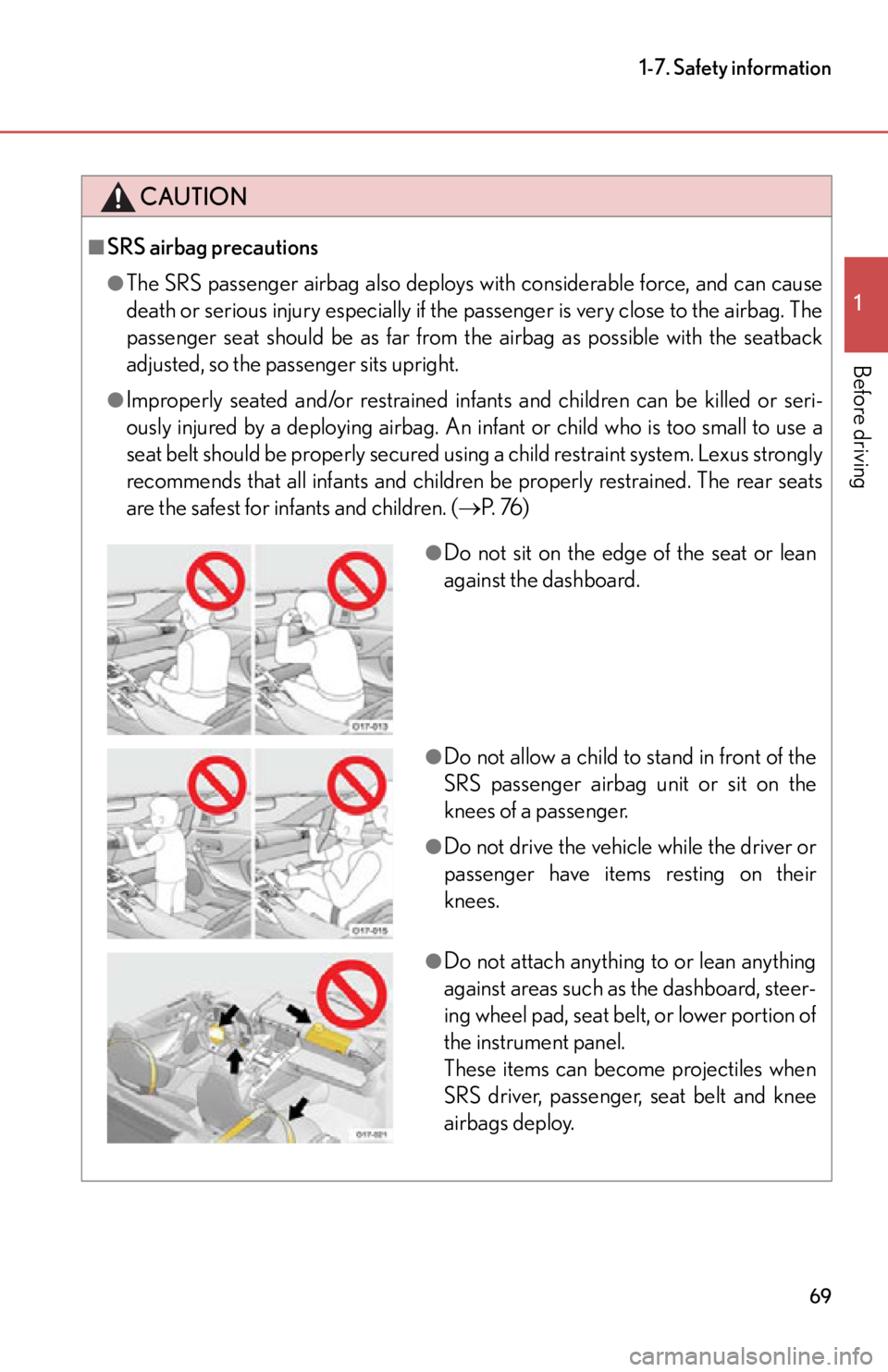2012 Lexus LFA ESP
[x] Cancel search: ESPPage 67 of 420

65
1-7. Safety information
1
Before driving
■SRS airbag deployment conditions
●The SRS front airbags will deploy in the event of an impact that exceeds the
set threshold level (the level of force corresponding to a 12 - 18 mph [20 - 30
km/h] frontal collision with a fixed wall that does not move or deform). In addi-
tion, the SRS seat belt airbags will also deploy in the event of an impact that
exceeds the set threshold level (the level of force corresponding to the impact
force produced by an approximately 3300 lb. [1500 kg] vehicle colliding with
the vehicle cabin from a direction perpendicular to the vehicle orientation at an
approximate speed of 12 - 18 mph [20 - 30 km/h]).
However, this threshold velocity will be considerably higher if the vehicle strikes
an object, such as a parked vehicle or sign pole, which can move or deform on
impact, or if the vehicle is involved in an underride collision (e.g. a collision in
which the front of the vehicle “underrides”, or goes under, the bed of a truck, etc.).
●It is possible that in some collisions where the forward deceleration of the vehi-
cle is very close to the designed thresh old level, the SRS front airbags and the
seat belt pretensioners ma y not activate together.
●The SRS passenger airbag will not activate if there is no passenger sitting in the
passenger seat. However, the passenger airbag may deploy if luggage is put in
the seat, or the seat belt is fastened , even if the seat is unoccupied. (P. 7 2 )
■Conditions under which the SRS airbags may deploy (inflate), other than a colli-
sion
The SRS front airbags may also deploy if a serious impact occurs to the underside of
your vehicle. Some examples are shown in the illustration.
●Hitting a curb, edge of pavement or hard
surface
●Falling into or jumping over a deep hole
●Landing hard or vehicle falling
Page 70 of 420

68
1-7. Safety information
CAUTION
■SRS airbag precautions
Observe the following precautions regarding the airbags.
Failure to do so may cause death or serious injury.
●The driver and passenger in the vehicle must wear their seat belts properly.
The SRS airbags are supplemental devices to be used with the seat belts.
●The SRS driver airbag deploys with considerable force, and can cause death or
serious injury especially if the driver is very close to the airbag. The National
Highway Traffic Safety Administration (“NHTSA”) advises:
Since the risk zone for the driver airbag is the first 2 - 3 in. (50 - 75 mm) of infla-
tion, placing yourself 10 in. (250 mm) from your driver airbag provides you with a
clear margin of safety. This distance is measured from the center of the steering
wheel to your breastbone. If you sit less than 10 in. (250 mm) away now, you can
change your driving position in several ways:
• Move your seat to the rear as far as you can while still reaching the pedals
comfortably.
• Slightly recline the back of the seat. Although vehicle designs vary, many dr ivers can achieve the 10 in. (250 mm)
distance, even with the driver’s seat all the way forward, simply by reclining
the back of the seat somewhat. If reclining the back of your seat makes it hard
to see the road, raise yourself by using a firm, or raise the seat if your vehicle
has that feature.
• If your steering wheel is adjustable, ti lt it downward. This points the airbag
toward your chest instead of your head and neck.
The seat should be adjusted as recommended by NHTSA above, while still main-
taining control of the foot pedals, steering wheel, and your view of the instrument
panel controls.
Page 71 of 420

69
1-7. Safety information
1
Before driving
CAUTION
■SRS airbag precautions
●The SRS passenger airbag also deploys with considerable force, and can cause
death or serious injury especially if the passenger is very close to the airbag. The
passenger seat should be as far from the airbag as possible with the seatback
adjusted, so the passenger sits upright.
●Improperly seated and/or restrained infants and children can be killed or seri-
ously injured by a deploying airbag. An infant or child who is too small to use a
seat belt should be properly secured using a child restraint system. Lexus strongly
recommends that all infants and children be properly restrained. The rear seats
are the safest for infants and children. ( P. 76 )
●Do not sit on the edge of the seat or lean
against the dashboard.
●Do not allow a child to stand in front of the
SRS passenger airbag unit or sit on the
knees of a passenger.
●Do not drive the vehicle while the driver or
passenger have items resting on their
knees.
●Do not attach anything to or lean anything
against areas such as the dashboard, steer-
ing wheel pad, seat belt, or lower portion of
the instrument panel.
These items can become projectiles when
SRS driver, passenger, seat belt and knee
airbags deploy.
Page 75 of 420

73
1-7. Safety information
1
Before driving
Condition and operation in the passenger occupant classification system
■Adult*1
■Child *3 or child restraint system*4
■Unoccupied
Indicator/
warning light “AIR BAG ON” and “AIR BAG OFF”
indicator lights “A I R B A G
ON”
SRS warning light Off
Passenger’s seat belt reminder light Flashing
*2
DevicesPassenger airbag
Activated
Seat belt airbag on the passenger seat
Passenger’s seat belt pretensioner
Indicator/
warning light “AIR BAG ON” and “AIR BAG OFF”
indicator lights “A I R B A G
OFF”
*5
SRS warning light Off
Passenger’s seat belt reminder light Flashing
*2
DevicesPassenger airbag
Deactivated
Seat belt airbag on the passenger seat
Passenger’s seat belt pretensioner Activated
Indicator/
warning light “AIR BAG ON” and “AIR BAG OFF”
indicator lights
Not illuminated
SRS warning light Off
Passenger’s seat belt reminder light
Devices Passenger airbag
Deactivated
Seat belt airbag on the passenger seat
Passenger’s seat belt pretensioner
Page 92 of 420

90
2-1. Driving procedures
■Engine speed restrictions
The following restrictions exist for engine protection:
●The engine speed is limited to 7400 rpm if the total mileage shown on the
odometer is less than 310 miles (500 km).
●The engine speed is limited when the engine is not sufficiently warmed-up, such
as immediately after the engine is started or during the engine warm-up period.
The variable red zone shows the maximum engine speed currently available.
( P. 1 1 9 )
●The engine speed is limited to 4400 rpm for approximately 8 minutes when the
engine is started with the coolant temperature at 5 F (-15 C) or lower.
●The engine speed may be limited when either the coolant temperature gauge
or oil temperature gauge is flashing.
■Idling with five cylinders
To improve fuel consumption, the engine may idle at a reduced speed using five cyl-
inders on one side of the engine whil e stopped or immediately before stopping
when 1st gear is selected in AUTO driving mode. During this time, “5 cylinders
idling” will be displayed on the meter an d vibration or a change in engine sound
may occur. This is normal and does not indicate a malfunction.
■ASG (Automated Sequential Gearbox) operating sounds
P. 1 1 0
■Braking sound
●As the LFA uses CCM (Carbon Ceramic Material) brake discs with high-fric-
tion pads, it may be possible to hear the sound of the brakes operating (such as
a rubbing or squealing sound). This is normal and does not indicate a malfunc-
tion.
●The sound of a motor operating may be heard after the engine is stopped. This
does not indicate a malfunction.
■Driving in the rain
●Drive carefully when it is raining, because visibility will be reduced, the windows
may become fogged-up, and the road will be slippery.
●Drive carefully when it starts to rain, because the road surface will be especially
slippery.
●Refrain from driving at high speeds on wet surfaces such as on an expressway in
the rain, as the LFA is fitted with wide-t read tires that may increase the risk of
hydroplaning.
Page 95 of 420

93
2-1. Driving procedures
2
When driving
CAUTION
■When the vehicle is stopped
●Do not race the engine.
• If the vehicle is in any gear other than Neutral the vehicle may accelerate sud-denly and unexpectedly, causing an accident.
• Running the engine at high speed while the vehicle is stopped may cause the exhaust system to overheat, which could result in a fire if flammable material is
nearby.
• Racing the engine may emit loud noise, and possibly cause a nuisance, espe- cially after just starting the engine. This is because the structure of the exhaust
pipes cause the sound emitted from the exhaust to be louder than usual for
approximately 1 minute after the engine is started.
●Do not leave the vehicle with the engine running for a long time.
If such a situation cannot be avoided, park the vehicle in an open space and
check that exhaust fumes do no t enter the vehicle interior.
●If the vehicle is stopped on an incline, in order to prevent accidents caused by the
vehicle rolling forward or backward, always depress the brake pedal and securely
apply the parking brake as needed.
■When the vehicle is parked
●Do not leave glasses, cigarette lighters, spray cans, or soft drink cans in the vehi-
cle when it is in the sun.
Doing so may result in the following:
• Gas may leak from a cigarette lighter or spray can, and may lead to a fire.
• The temperature inside the vehicle may cause the plastic lenses and plastic material of glasses to deform or crack.
• Soft drink cans may fracture, causing the contents to spray over the interior of
the vehicle, and may also cause a short circuit in the vehicle's electrical com-
ponents.
●Do not leave cigarette lighters in the vehicle. If a cigarette lighter is in a place such
as the glove box or on the floor, it may be lit accidentally when luggage is loaded
or the seat is adjusted, causing a fire.
●Do not attach adhesive discs to the wind shield or windows. Do not place contain-
ers such as air fresheners on the instru ment panel or dashboard. Adhesive discs
or containers may act as lenses, causing a fire in the vehicle.
Page 97 of 420

95
2-1. Driving procedures
2
When driving
CAUTION
■Exhaust gases
Exhaust gases include harmful carbon monoxide (CO), which is colorless and
odorless. Inhaling exhaust gases may lead to death or a serious health hazard.
●If the vehicle is in a poorly ventilated ar ea, stop the engine. In a closed area, such
as a garage, exhaust gases may collect and enter the vehicle. This may lead to
death or a serious health hazard.
●The exhaust system should be checked occasionally. If there is a hole or crack
caused by corrosion, damage to a joint or abnormal exhaust noise, be sure to
have the vehicle inspected and repaired by your Lexus dealer. Failure to do so
may allow exhaust gases to enter the vehicl e, resulting in death or a serious health
hazard.
■When taking a nap in the vehicle
Always turn the engine off. If you take a nap with the engine on, you may acciden-
tally depress the accelerator and an accident or fire may occur due to engine over-
heating. In addition, if the vehicle is parked in a poorly ventilated area, exhaust gases
may enter the vehicle, leading to death or a serious health hazard.
■When braking the vehicle
●Be especially careful if the brakes are wet, such as when driving on wet or snowy
roads or immediately after washing the vehicle. When the brakes are wet, their
efficiency may be reduced and the vehicle may brake unevenly to the left or right.
The efficiency of the parking brake may also be reduced.
●The brake system consists of 3 individual hydraulic systems; if one of the systems
fails, the others will still operate. In th is case, the brake pedal should be depressed
more firmly than usual and the braking distance will increase. If this happens, do
not continue to drive the vehicle. If the brake system warning light (red indicator)
comes on together with the buzzer sound while driving, immediately stop the
vehicle in a safe place and contact your Lexus dealer.
Page 112 of 420

110
2-1. Driving procedures
■Shift speed
●When the driving mode is changed, the shift speed levels will be set as follows:
●Shift shock increases as the shift speed becomes faster.
■When parking the vehicle
There is no P (Park) setting for the ASG. When parking the vehicle, set the parking
brake, select 1st gear or Reverse, and ch eck that the gear indicator shows “D1”, “1”
or “R” before stopping the engine.
●Approximately one second after the engine is stopped, the vehicle will enter a
parked gear state.
If the vehicle fails to enter a parked gear state, a buzzer sounds and the gear
indicator flashes. Select Neutral and then follow the same procedure again.
●Make sure to stop the engine. Opening the driver’s door without first stopping
the engine will cause a warning to sound and Neutral to be automatically
selected after 5 seconds. Even if the driver’s door is not opened, a warning will
sound and Neutral will be automatically selected after 90 seconds.
■ASG operating sounds
●Even when the engine is stopped, operating sounds of the electric oil pump may
be heard. This is normal and does not indicate a malfunction.
●As the drive train of the LFA is designed to be especially responsive to acceler-
ator pedal operation, a sound may be heard from the transaxle when driving at
low engine speeds. This does not indicate a malfunction.
■Customization that can be configured at your Lexus dealer
The sound pattern of the reverse warning buzzer can be changed.
(Customizable features P. 383)
Driving modeDefault levelAdjustable range
AUTO 2
SPORT 5 1 7
NORMAL 3
WET 1